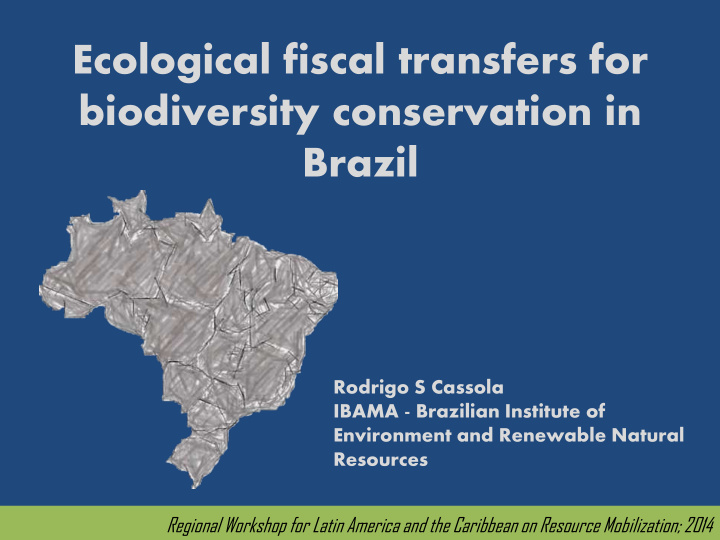



Ecological fiscal transfers for biodiversity conservation in Brazil Rodrigo S Cassola IBAMA - Brazilian Institute of Environment and Renewable Natural Resources Regional Workshop for Latin America and the Caribbean on Resource Mobilization; 2014
Key Messages • The role of subnational governments , and related costs, in biodiversity conservation policy implementation has to be acknowledged • Ecological fiscal transfer as suitable policy instrument to provide incentives for subnational governments and support implementation of biodiversity conservation policies • Ecological fiscal transfers use has been limited , there is potential for a greater role in the context of scaling up financing for conservation 2
The problem Costs → subnational governments Benefits → national/global level decisions and an allocation of resources that might not be the most efficient in a national perspective 3
The instrument Intergovernmental fiscal transfers → mechanisms higher levels of government adopt to share revenues with lower levels Ecological fiscal transfers (EFT)- any kind of intergovernmental grants that explicitly incorporates ecological indicators In developing countries, grants represent 60% of subnational government budgets, in comparison to about 30% in OECD countries 4
Brazil: EFT experience ICMS ECOLÓGICO Target local level • Compensatory • Protected areas as • primary indicator 5 Source: icmsecologico.org
ICMS-E: Parana Since early 90´s • 5% of mandatory ICMS • transfers US$ 70 million (2009) • Quantitative criteria • plus “quality index” Cassola (2010) 6 Source: icmsecologico.org
ICMS-E: Mato Grosso Since 2002 • 5% of mandatory ICMS • transfers US$ 25 million (2009) • Quantitative • assessment May et al. (2012) 7 Source: icmsecologico.org
ICMS-E: Para Since 2013 • 8% of mandatory ICMS • transfers Still no transfers • Prerequisites • Relevant new criteria • Avoided deforestation • Forest stock • Forest Law • implementation 8 Source: icmsecologico.org
The case for a Federal-state EFT in Brazil Reward commitment to national targets (Spillover benefits)
The case for a Federal-state EFT in Brazil Reward commitment to national targets (Spillover benefits) Compensate costs of biodiversity policy implementation
The case for a Federal-state EFT in Brazil Reward commitment to national targets (Spillover benefits) Compensate costs of biodiversity policy implementation Compensate land use restrictions (Opportunity costs)
An option: FPE Verde • Adding ecological indicators to the Fundo de Participação dos Estados (largest federal-state IFT in Brazil) R$ 1.05 billion (~US$ 480 million) FPE Verde = 2% of FPE funds R$ 53.3 billion (2013) (~US$24 billion) 12
FPE Verde: indicator selection Relevance for Possible Availability of biodiversity incentive effects data conservation Protected area coverage Protected area category Protected area management level Biological importance National conservation targets Protected area management effectiveness Opportunity costs Deforestation and land degradation rates Vegetation fire frequency 13
FPE Verde: indicator selection Relevance for Possible Availability of biodiversity incentive effects data conservation Protected area coverage Protected area category Protected area management level Biological importance National conservation targets Protected area management effectiveness Opportunity costs Deforestation and land degradation rates Vegetation fire frequency 14
FPE Verde: scenarios EX-ANTE SCENARIO ANALYSIS BASIC 2 and BASIC ALTERNATE ALTERNATE2 Existing law proposal Product of this study. Same design as previous two, only difference: how to get the 2% that forms FPE Verde Classify States into 7 Incorporate selected classes of protected area indicators. coverage
FPE Verde: winners and losers 16
Policymix: other economic instruments in Brazil IN PLACE / ONGOING PERSPECTIVES / ON STUDY 1. Environmental compensation 1. Federal PES Law schemes (infrastructure projects) 2. Green Infrastructure Bonds 2. Environmental funds (Fundo Amazônia & FUNBIO) 3. Tradable conservation certificates 3. State and Municipal PES Laws and (Forest Law – needs regulation) schemes 4. EFT targeting Amazon States based 4. Green procurement on deforestation results 5. Forest allowance programs (Bolsa 5. ... Floresta and Bolsa Verde) 6. ... 17
Thank you for your attention Acknowledgements: IBAMA/MMA DAAD University of Freiburg UFZ, Leipzig Rodrigo S Cassola Note: The views and opinions are mine and do not necessarily rodrigo.cassola@ibama.gov.br reflect the position of the Brazilian government
References • Ring, I., 2008. Integrating local ecological services into intergovernmental fiscal transfers: the case of the ecological ICMS in Brazil. Land use policy 25(4), 485-497. • Cassola R. (2010) TEEBcase: Financing conservation through ecological fiscal transfers Brazil, mainly based on Ring (2008). Available at: http://www.teebweb.org • May, P. et al. (2012) Assessment of the role of economic and regulatory instruments in the conservation policymix for the Brazilian Amazon – a coarse grain study. Report 5/2012. Available at: http://policymix.nina.no • www.icmsecologico.org.br • http://policymix.nina.no 19
Recommend
More recommend